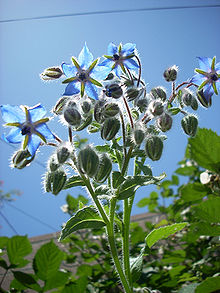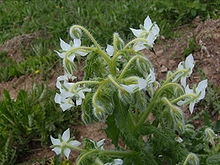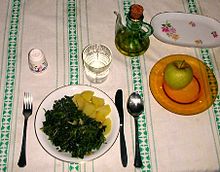
Borage
Background Information
Arranging a Wikipedia selection for schools in the developing world without internet was an initiative by SOS Children. SOS Children is the world's largest charity giving orphaned and abandoned children the chance of family life.
| Borage | |
|---|---|
 |
|
| Borage flower | |
| Scientific classification | |
| Kingdom: | Plantae |
| (unranked): | Angiosperms |
| (unranked): | Eudicots |
| (unranked): | Asterids |
| Order: | (unplaced) |
| Family: | Boraginaceae |
| Genus: | Borago |
| Species: | B. officinalis |
| Binomial name | |
| Borago officinalis L. |
|
Borage (Borago officinalis), also known as a starflower, is an annual herb. It is native to the Mediterranean region and has naturalized in many other locales. It grows satisfactorily in gardens in the UK climate, remaining in the garden from year to year by self-seeding. The leaves are edible and the plant is grown in gardens for that purpose in some parts of Europe. The plant is also commercially cultivated for borage seed oil extracted from its seeds.
Appearance
It grows to a height of 60–100 cm (2.0–3.3 ft), and is bristly or hairy all over the stems and leaves; the leaves are alternate, simple, and 5–15 cm (2.0–5.9 in) long. The flowers are complete, perfect with five narrow, triangular-pointed petals. Flowers are most often blue in colour, although pink flowers are sometimes observed. White flowered types are also cultivated. The blue flower is genetically dominant over the white flower. The flowers arise along scorpioid cymes to form large floral displays with multiple flowers blooming simultaneously, suggesting that borage has a high degree of geitonogamy (intra-plant pollination). It has an indeterminate growth habit which may lead to prolific spreading. In temperate climate such as in the UK, its flowering season is relatively long, from June to September. In milder climates, borage will bloom continuously for most of the year.
Characteristics and uses

Traditionally borage was cultivated for culinary and medicinal uses, although today commercial cultivation is mainly as an oilseed. The seed oil is desired as source of gamma-linolenic acid (GLA, 18:3, cis 6,9,12-octadecatrienoic acid), for which borage is the highest known plant-based source (17-28%). The seed oil content is between 26-38% and in addition to GLA contains the fatty acids palmitic acid (10-11%), stearic acid (3.5-4.5%), oleic acid (16-20%), linoleic acid (35-38%), eicosenoic acid (3.5-5.5%), erucic acid (1.5-3.5%), and nervonic acid (1.5%). The oil is often marketed as "starflower oil" or "borage oil" for uses as a GLA supplement, although healthy adults will typically produce ample GLA through dietary linoleic acid.
Borage production does include use as either a fresh vegetable or a dried herb. As a fresh vegetable, borage, with a cucumber like taste, is often used in salads or as a garnish. The flower, which contains the non-toxic pyrrolizidine alkaloid thesinine, has a sweet honey-like taste and as one of the few truly blue-colored edible substances, is often used to decorate dessert. It is notable that the leaves have been found to contain small amounts (10 ppm of dried herb) of the liver-toxic pyrrolizidine alkaloids: intermedine, lycopsamine, amabiline and supinine. The levels are extremely low (2-10 ppm). Leaves contain mainly the toxic lycopsamine also amabiline and the non-toxic saturated PA thesinine (the only alkaloid found in seed contained thesinine and amabiline in a ratio of 10:1). No alkaloids have been found so far in seed oil.
Vegetable use of borage is common in Germany, in the Spanish regions of Aragón and Navarra, in the Greek island of Crete and in the Italian northern region Liguria. Although often used in soups, one of the better known German borage recipes is the Green Sauce (Grüne Soße) made in Frankfurt. In Italian Liguria, borage is commonly used as filling of the traditional pasta ravioli and pansoti. The leaves and flowers were originally used in Pimms before it was replaced by mint or cucumber peel. It is used to flavour pickled gherkins in Poland.
Borage is also traditionally used as a garnish in the Pimms Cup cocktail, but is sometimes replaced by a long sliver of cucumber peel if not available. It is also one of the key "Botanical" flavourings in Gilpin's Westmorland Extra Dry Gin. Borage leaves have a cucumber like flavor.
In Iran people sometimes put it in their tea.
Traditional medicine
Traditionally Borago officinalis is used in hyperactive gastrointestinal, respiratory and cardiovascular disorders, such as gastrointestinal (colic, cramps, diarrhea), airways (asthma, bronchitis), cardiovascular, (cardiotonic, antihypertensive and blood purifier), urinary (diuretic and kidney/bladder disorders).
Naturopathic practitioners use borage for regulation of metabolism and the hormonal system, and consider it to be a good remedy for PMS and menopause symptoms such as the hot flush. The flowers can be prepared in infusion.
One case of status epilepticus has been reported that was associated with borage oil ingestion.
A methanol extract of borage has shown strong amoebicidal activity. The 50% inhibitory concentration ( LD50) of the extract for Entamoeba histolytica was only 33 µg/mL.
Companion plant
Borage is used in companion planting. It is said to protect or nurse legumes, spinach, brassicas, and even strawberries. It is also said to be a good companion plant to tomatoes because it confuses the search image of the mother moths of tomato hornworms or manduca looking for a place to lay their eggs. Claims that it improves tomato growth and makes them taste better remain unsubstantiated.


